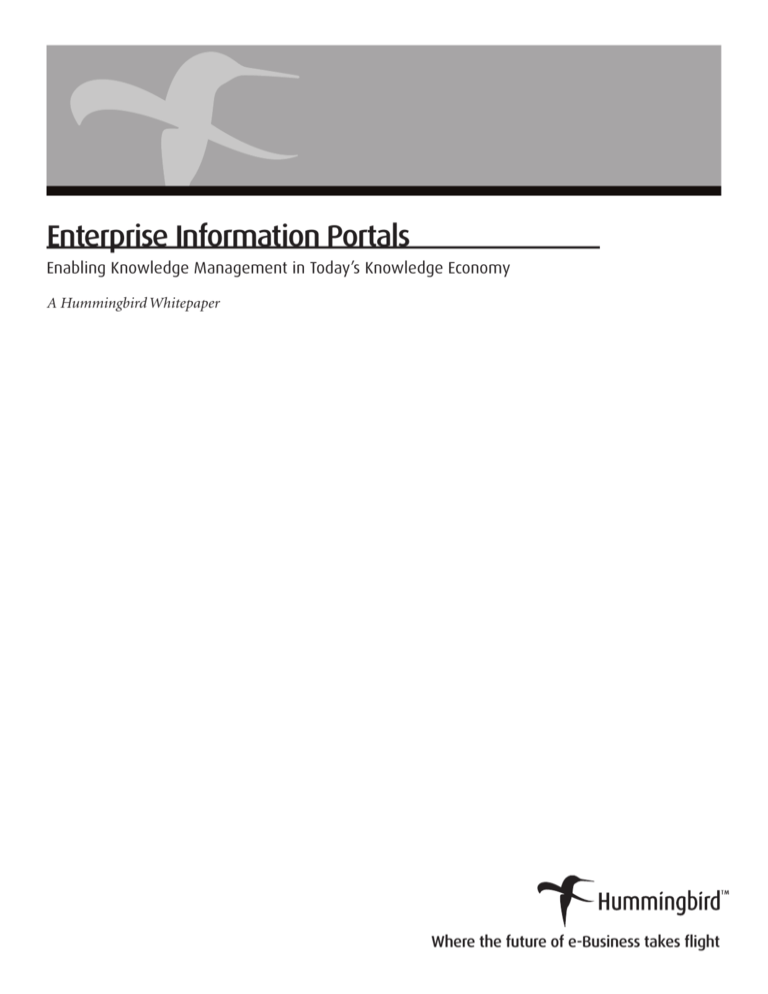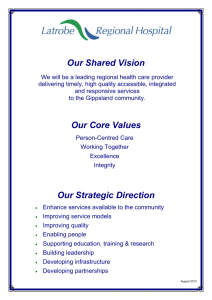
Enterprise Information Portals
Enabling Knowledge Management in Today’s Knowledge Economy
A Hummingbird Whitepaper
Where the future of e-Business takes flight
Enterprise Information Portals
While every attempt has been made to ensure the accuracy and completeness of the
information in this document, some typographical or technical errors may exist. Hummingbird
cannot accept responsibility for customers’ losses resulting from the use of this document. The
information contained in this document is subject to change without notice.
This document contains proprietary information that is protected by copyright. This
document, in whole or in part, may not be photocopied, reproduced, or translated into another
language without prior written consent from Hummingbird.
This edition published October 2001
2
Hummingbird Ltd.
Table of Contents
Introduction
....................................................
Defining Knowledge Management and its Strategic Initiatives
............
The Five Technology Blocks of Enterprise Knowledge Management
6
9
........
10
Key Knowledge Management Enabling Technologies . . . . . . . . . . . . . . . . . . . .
11
Knowledge Portals and the Intelligent Enterprise . . . . . . . . . . . . . . . . . . . . . . . .
12
Organizational and Cultural Aspects of Implementing KM
................
14
Knowledge Management Value Chain . . . . . . . . . . . . . . . . . . . . . . . . . . . . . . . .
16
Summary . . . . . . . . . . . . . . . . . . . . . . . . . . . . . . . . . . . . . . . . . . . . . . . . . . . . . . . .
17
3
Enterprise Information Portals
4
Hummingbird Ltd.
Enabling Knowledge Management in Today’s Knowledge Economy
Abstract
The most daunting challenge facing business management is delivering information to the
virtual organization worldwide—information anytime, anywhere, and on any device. Web
technologies are the foundation of today’s intranets and over the past six years business,
government, and education have discovered the power of these technologies as a new
computing paradigm for information sharing and collaborative computing. The enterprise
information portal (EIP) represents a significant evolution in the advancement of the
organizational Intranets and graphical user environments (GUE). EIP technologies are
rapidly becoming the foundation for many B2E, B2C and B2B e-commerce initiatives.
As a powerful enabling technology, the EIP’s ability to aggregate information and
enterprise applications into a Web-enabled GUE facilitates many strategic organizational
initiatives including collaborative e-commerce, customer relationship management (CRM),
and knowledge management (KM) — including intellectual capital management and the
development of communities of interest/best practice. The overall objective of this paper
is to provide a comprehensive vendor-neutral overview of EIP and KM technologies and
illustrate how they can increase organizational productivity and speed to innovation.
Hummingbird hopes that this discussion will help identify many KM enabling technologies
and be an aide in your decision making process.
5
Enterprise Information Portals
Introduction
In July 1999, sixty managers of Siemens’ telecommunications division were deposited on
the shores of Lake Starnberger south of Munich, Germany. They were told they had
to build rafts without using speech. The objective: one of the most seminal aspects of
any knowledge management initiative, learning to win by sharing (see Business Week
March 19, 2001). Knowledge management (KM) is back in vogue and its one of the top
organizational information technology initiatives for business today. The challenges associated
with implementing knowledge management systems extend far beyond the capabilities of most
information technology and line of business managers. KM is much more than technology
— transcending the worlds of organizational development, industrial and organizational
psychology — KM is all about sociology, anthropology, culture, politics, people, and
business processes. Beyond the realms of enabling technologies such as federated search
and business content management, knowledge management becomes 95 percent culture and
5 percent technology, and represents significant organizational challenges well beyond what
any technology can facilitate. The overall challenge faced by many organizations today is
identifying where strategic knowledge (intellectual capital) resides and how to leverage and
manage it across the enterprise, group and/or individual.
From a software vendor perspective, today’s knowledge management market is highly
fragmented and has undergone a great deal of uncertainty because of the confusing nature
of its enabling technologies and the inherent organizational and cultural difficulties in their
application. According to a recent Merrill Lynch report, the market for enabling technologies
that facilitate knowledge management systems is expected to enjoy a 30 percent compound
annual growth over the next four years, skyrocketing from $97 million in 1999 to over
$500 million by the year 2004 (see graph on the next page). More importantly, this forecast
clearly reinforces the concept that KM is 95 percent people/processes and culture and not
technology, as the majority of technology growth is in information management (business
content management) and classification systems.
The knowledge management business drivers are primarily the result of our evolution from
the Internet-information age into what now might be termed a knowledge-based economy.
The Internet and easy information access has created market chaos for some businesses
and increased business complexity for many others. In other words, “If you don’t have your
eBusiness house in order, customers may know it before you do.” Easy access to information
anytime, anywhere, anyhow, and on any device has significantly compressed business response
time overall. In addition, historically businesses have been challenged by managing and
leveraging intellectual capital, and many organizations now realize that their most valuable
resources drive home every night.
6
Hummingbird Ltd.
Enabling Knowledge Management in Today’s Knowledge Economy
Search/Indexing and Retrival, Content, Knowledge Environments Market
Source: Merrill Lynch
KM Management
Content Management
Search
3500
3000
2500
2000
1500
1000
500
0
1999
2000
2001
2002
2003
2004
Millions of Dollars, Total Market Size $4.6 Billion in 2004
Industrial Economy— Information Economy— Knowledge Economy
In the past, many KM initiatives failed in part because of the complexity involved in
implementing KM systems, organizational barriers, and/or management’s failure to address
important cultural issues inherent in their organization or business process. For example,
if a non-information sharing culture exists within the enterprise, KM may be doomed to
failure from the very beginning. Successful KM initiatives today are significantly scaled
down, have buy-in at the executive level, and are designed to enhance a specific business
process by increasing the productivity of knowledge workers. Productivity can be increased
by facilitating information sharing through collaboration, which can ultimately lead to the
identification and capture of intellectual assets through the creation of communities of
interest and/or best practices. Communities of interest/best practice foster information and
in the best of all worlds lead to the creation of new and better ways of conducting business,
or in simpler terms innovation.
In most organizations KM initiatives begin with the implementation of information
management technologies; which are closely coupled with complementary enabling
technologies such as federated search and taxonomy (indexing and classification of
information resources). Perhaps the most important advance in knowledge management
enabling technologies to emerge in recent years is the enterprise information portal (EIP),
or corporate portal. B2E EIPs are rapidly becoming an important component of today’s
organizational eBusiness infrastructure and are much more than intranets on steroids.
7
Enterprise Information Portals
Defining Organizational Knowledge
Before we can actually begin an organized discussion of KM, its important to define what
knowledge is and how it can be captured and leveraged. There are three types of knowledge
within any organization, individual, group and enterprise, and that knowledge can be generally
classified along the lines of being explicit, embedded, and tacit. The overall challenge that
many organizations face today is identifying where that knowledge resides and how to
leverage it across the enterprise, group and/or individual. The majority of KM initiatives today
usually revolve around identifying/discovering, classifying and indexing explicit knowledge in
information systems, such as an enterprise document management system, and/or business
content management system. In many cases KM systems also include access to structured
information found in databases.
• Explicit Knowledge—knowledge represented in documents, books, e-mail and
databases.
• Embedded Knowledge—organizational knowledge found in business processes,
products and services.
• Tacit knowledge—undocumented knowledge that is captured during business
processes by knowledge workers.
8
Hummingbird Ltd.
Enabling Knowledge Management in Today’s Knowledge Economy
Defining Knowledge Management and its Strategic
Initiatives
As an organizational initiative, knowledge management is usually manifested in the form
of a business system that is enabled by an array of technologies. Today the convergence of
knowledge management and business intelligence (BI) is underway in many organizations
and KM enabling technologies are a vital part of any customers relationship management
system. From an organizational perspective, CRM, intellectual capital management (ICM),
communities of interest or best practices (BPM), and competitive intelligence all fall under
the umbrella of knowledge management.
Strategic Knowledge Management Initiatives
• Customer Relationship Management
• Intellectual Capital Management
• Best Practices Management
• Competitive Intelligence
• Community of Interest Building
• eLearning-eTraining-eMentoring
One of the greatest difficulties in defining KM is the level of complexity inherent in many
of the definitions themselves, and in their scope. This is perhaps the most difficult and
confusing aspect of understanding what KM is and how it can be implemented from
an organizational and/or business unit perspective. The graphic below depicts the five
major technology blocks that are required to build a business-critical enterprise-wide KM
foundation.
The Five Technology Blocks of Enterprise Knowledge Management
Enterprise
Information
Portal
Federated
Search
Information
Management
System
Business
Intelligence
Collaboration
9
Enterprise Information Portals
The Five Technology Blocks of Enterprise Knowledge
Management
1. The Enterprise Information Portal—The EIP, or corporate portal, can be the focal point
of an organization’s KM initiatives and can facilitate a comprehensive range of functionality
including, single point of access to relevant structured and unstructured information,
community of interest building, and collaboration. Note that it is not a replacement for
Windows graphical user interface.
2. Information Management Systems—For example, if you don’t have an information
management system in place that facilitates the organization, indexing, classification of
documents, content, and digital assets (such as video and audio files), illustrations, records,
policies and procedures, etc., then it will be nearly impossible to build and effective KM
business system. Surprisingly, many companies in a wide range of industry segments have
yet to build this type of enterprise-wide information system.
3. Federated Search—As defined in the KM enabling technology table below, this is the ability
to search across all organizational structured (databases) and unstructured (documents,
records, e-mails, video & audio files, etc.) information sources via a single technology
(search engine). This is a seminal enabling technology that facilitates discovery of intranet
and Internet information and data sources.
4. Business Intelligence—Formerly known as decision support, many business intelligence
(BI) systems where designed for specific business objectives such as data warehousing
financial information for routine data analysis, standard report writing, adhoc querying,
OLAP and data mining. Many BI systems are now being deployed to deliver on the promise
of CRM initiatives, which are significantly more complex than data warehousing of financial data.
5. Collaboration—Electronic mail is still the most collaborative technology in most
enterprises, however, a new class of collaborative technologies is emerging that can
greatly facilitate workplace collaboration and the creation of communities of interest/best
practices. These technologies enable virtual workspaces and workrooms that allow members
to share documents, e-mails, schedules and collaborative document creation, in effect
enabling collaborative e-commerce.
10 Hummingbird Ltd.
Enabling Knowledge Management in Today’s Knowledge Economy
The table below identifies key KM enabling technologies and how they can be applied to
address organizational and business unit initiatives.
Key Knowledge Management Enabling Technologies
B2E Enterprise Information Portal
Provides a single point of access to all relevant information and
applications, while also functioning as a gateway to communities of
interest best practice etc. EIPs can also function as a platform for
knowledge networks.
Federated Search
The ability to search across all organizational structured (databases)
and unstructured (documents, records, e-mails, video & audio files, etc)
information sources via a single technology (search engine).
Taxonomy, Classification Indexing
of Information Sources
Indexing of information resources and establishment and/or
automation of an information taxonomy for industry specific or
organizationally specific information.
Document/Information
Management Systems
Organization and archiving of documents, e-mails, files, illustrations,
policies, procedures, records, audio files, video files, etc.
Collaborative eCommerce
application environments and/or
workspaces.
Enable organizations to easily create virtual project team rooms,
and/or communities of best practice by allowing team members to
collaboratively develop and store documents, tasks and schedules in a
secure virtual environment.
Simultaneous collaboration
Allow workgroups and project team members to share information in
real-time.
Business Process Management
Community of Interest Building
Facilitates best practices and community of interest building by
leveraging an EIP front end with threaded discussion groups and
collaborative technologies through an EIP.
Intelligent agents-Web crawlers,
knowbots
Enable relevant information derived from automated searching to be
pushed to the desktop or added to a repository.
Network News & Threaded
discussion groups
One of the first technologies of the Web to be employed as a KM
system for sharing information on projects and topics. Can also serve as
a key technology for facilitating ementoring.
Chat/Instant messaging
A technology that evolved from Internet Relay chat, enables real-time
person-to-person interaction.
Automated community building
software
A new class of software that automatically builds communities of
interest by profiling e-mail and documents.
Visualization software
For information systems.
A new class of software that provides more intuitive and easier
interface for navigating information systems including Web sites, this
new way of viewing information can significantly enhance information
discovery and access.
Expert Systems
Another new class of software that connects organizational experts
with other members of the community by asking questions like “who
knows about this?”
11
Enterprise Information Portals
Knowledge Portals and the Intelligenct Enterprise
Enterprise information portals are bringing together the worlds of business intelligence and
knowledge management into a new, centralized desktop environment—the knowledge portal.
In the millennium, the knowledge portal will play a key role in empowering the virtual
enterprise and employees by providing a personalized single point of access to all relevant
information— enabling better, faster-decision making. EIPs, or knowledge portals, are also
beginning to help organizations capture and leverage their intellectual assets by facilitating
assembly of communities of interest, best practice, and expert systems within a single,
intuitive, Web-based user interface. The EIP should be viewed as an evolving technology
platform, and in the future EIPs will incorporate streaming video and audio to include
e-learning and e-training components, thereby potentially reducing overall organizational
training costs.
Hummingbird Enterprise Information Portal™: Empowering the Virtual Enterprise.
12 Hummingbird Ltd.
Enabling Knowledge Management in Today’s Knowledge Economy
The EIP is the Convergence of KM & BI
eLearning
Knowledge
Management
• Taxonomy
• Search
• Community Building
EIP
Knowledge
Desktop
Business
Intelligence
• Data Mining
• Query & Reporting
• Pre-Packaged Analytical
Applications
• OLAP
• CRM
• ETL
Digital Asset
Management
• Content Management
• Document Management
Knowledge Management Functionalities Aggregated within an EIP
• Search/discovery and navigation to information from a knowledge map.
• Taxonomy, relevant indexing and classification of information sources.
• Knowledge network, user interface to communities of interest/expert systems
• Personalization and presentation of relevant information to the desktop.
• Dynamic delivery of information to the desktop via intelligent agents.
• Enterprise application integration
13
Enterprise Information Portals
Organizational and Cultural Aspects of Implementing KM
Leading edge organizations have created a whole new class of business managers — called
knowledge managers, knowledge environment engineers, best practices managers, and/or
information architects to name a few. KM often starts at the top and its most difficult
challenge is establishing a culture of getting people to work together and share information.
By facilitating information access, sharing, and collaboration, an organization, business unit,
or department can create best practices that ultimately lead to innovation and optimization
of business processes. Increasing productivity and innovation are the seminal goals of any
KM system, which can ultimately lead to increased competitiveness and success in any market
segment. If your organization has a culture of not sharing information and senior management
is not behind KM, then it is likely to fail. However, some KM initiatives are done under the radar
of management and become highly successful, such as the Xerox Eureka project, (see Darwin
Magazine February 2001). The Xerox Eureka project successfully leveraged the experience and
knowledge of Xerox repairmen and resulted in saving the company millions in extraneous
repair costs.
Building communities of interest and/or promoting best practices within an organization is
more easily said then done, however, and the major barriers to successful implementation
are primarily cultural, not information technology driven. We all live in a highly competitive
society and workplace and some employees are not normally accustomed or open to sharing
information.
Organizational Barriers to Building Communities of Interest and
Expert Systems
• Senior management culture and support — “Where is the ROI?”
• Identifying the knowledge base — “Who really knows about this?”
• Buy in from knowledge workers and employees — “What’s in it for me?”
• Management and distribution of relevant and accurate content — “Does this really work?”
Successful KM initiatives are often focused on strategic business initiatives, and many
organizations implement KM systems when they realize that the absence and/or loss of
intellectual assets could negatively impact business. Often organizations search for and realize
areas where they are vulnerable and are dependent on the knowledge and expertise of
consultants and other knowledge workers. For example, a health care organization may have a
virtual workforce of consultants in the field and headquarters may have no idea how they do
their jobs. Or, a political organization may want to capture and archive the knowledge gained
during the process of executing a campaign. This may include leveraging all of the information,
documents, advertisements, speeches, and illustrations into future campaigns, however, the real
“gold” is in the how to part of the campaign process — not the end-result elements themselves,
but the processes and planning that surrounded those elements.
14 Hummingbird Ltd.
Enabling Knowledge Management in Today’s Knowledge Economy
One of the fastest growing and most challenging areas in knowledge management is the
capturing of tacit information and intellectual assets through the building of communities
of interest. Intellectual capital management (ICM) is an overused term that is different for
almost every organization. In an effort to preserve intellectual capital, some organizations
video interview all retirees as part of their exit processing – often running into the
tens of hours due to the fact that the retiree may have 20+ years of experience with
the organization. Obviously, this is an inefficient practice… Today’s knowledge-based
organization must find ways of capturing and repurposing expertise and tacit information.
Some of the challenges faced by organizations include identifying what is intellectual
capital, where it resides within the organization, and how the organization may be impacted
(vulnerability) by the absence of this information.
15
Enterprise Information Portals
Knowledge Management Value Chain
The following graphic depicts a “big picture” perspective on the organizational value of
knowledge management. Before information can become relevant knowledge, it must be
logically organized—building block two the IMS system—easily accessible for exploration—
building block one the EIP—search and discovery—building block three, federated search.
In the simplest of terms many organizations are now in the process of enabling information
by essentially data warehousing unstructured data sources such as document and business
content management archives.
The Knowledge Management Value Chain
Information Becomes Knowledge
Knowledge Facilitates Innovation
Knowledge Enables Action
Explore
Organize
Access
Collaborate
Discover
Act
Investigate
Discovery and exploration of relevant information enables employees and the organization
to act and collaborate—building block five, collaboration—which may ultimately lead
to innovation of business processes resulting in increased competitiveness and higher
profitability. Earlier we identified the convergence of BI and KM in facilitating CRM
initiatives—building block four, business intelligence—with tools such as query and
reporting, data mining, and online analytical processing (OLAP), that all enable access to
structured information in databases.
16 Hummingbird Ltd.
Enabling Knowledge Management in Today’s Knowledge Economy
Summary
Although knowledge management has become a strategic initiative in many organizations,
it presents many and significant organizational challenges to all levels of management,
including line of business managers and IT professionals. The confusing nature of the
KM market is due in part to the broadness and complexity of the enabling technologies,
and how it is defined and implemented in different organizations. KM’s limited success in
the past has been primarily the result of organizations taking a technology-only approach
to those initiatives rather than addressing the salient cultural and organizational issues.
Interestingly, when you ask many IT professionals what KM is, the typical responses usually
include the first three bullets listed below, and in some cases collaboration.
Knowledge Management in Most Organizations
• Information-document-content management system.
• Federated search (the ability to search and discover information)
• Taxonomy (classification and indexing of information and documents)
• Collaboration and/or workflow
• Community of interest/ best practice/expert systems
• Intelligent agents (for dynamic assembly and personalization of information)
The most daunting challenge facing business management today is delivering information
utopia to the virtual organization worldwide—information anytime, anywhere, and on
any device. The technologies of the Web created the foundation of today’s intranets, and
over the past six years business, government, and education have discovered the power of
Internet and Web technologies as a new computing paradigm for information sharing and
collaborative computing within the enterprise.
The enterprise information portal represents the next significant evolution in the
advancement of the organizational Intranets and graphical user environments (GUE).
EIP technologies are rapidly becoming the foundation for B2E, B2C and B2B eCommerce
initiatives. As powerful enabling technology, an EIP’s ability to aggregate information and
enterprise applications into a Web-enabled GUE facilitates many strategic organizational
initiatives including: collaborative eCommerce, CRM, knowledge management: intellectual
capital management and communities of interest/best practice. Again, Hummingbird hopes
that this discussion provides a broad and comprehensive overview of EIP and KM
technologies, and serves as an aide in your decision making process.
17
Enterprise Information Portals
References
Burden, Paul, Knowledge Management The Bibliography, Asis Monograph Series, Information
Today, Inc Medford New Jersey, 2000
Ewing, Jack, Sharing The Wealth, Business Week, March 19, 2001 pp. 36-40
Koulopoulos, Tom and Frappaolo, Carl, Smart Things To Know About Knowledge Management,
Capstone Publishing Limited, Oxford United Kingdom, 1999
Srikantaiah, T & Koenig, Michael, Knowledge Management For the Information Professional, Asis
Monograph Series, Information Today, Inc Medford New Jersey, 2000
Suskind, Richard, Transforming The Law: Essays on Technology Justice and the Legal
Marketplace, Oxford University Press, 2000
18 Hummingbird Ltd.
Corporate Headquarters
1 Sparks Avenue
Toronto, Ontario M2H 2W1
Canada
Toll Free Canada/USA:
+1 877 FLY HUMM (359 4866)
Tel:
+1 416 496 2200
Fax:
+1 416 496 2207
E-mail:
getinfo@hummingbird.com
North American Sales Offices
Boston • Chicago • Dallas • Los Angeles
New York • Ottawa • Raleigh
San Francisco • Toronto • Washington DC
International Sales Offices
Amsterdam • Berlin • Brussels • Frankfurt
Geneva • Hong Kong • London • Mexico City
Milan • Munich • Paris • Rome • Seoul
Singapore • Stockholm • Sydney • Tokyo
For more information, visit
www.hummingbird.com
Copyright © 2001, Hummingbird Ltd.
All rights reserved.
® ™ — Trademarks and logos are the
intellectual property of Hummingbird Ltd.
All other company and product names are
trademarks of their respective owners.




